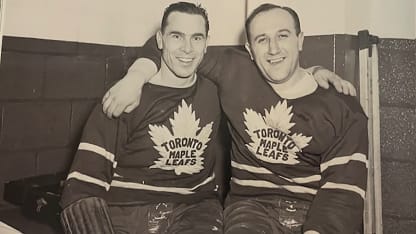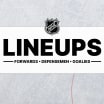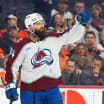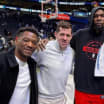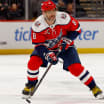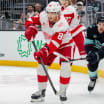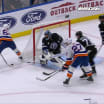Legendary hockey reporter Stan Fischler writes a weekly scrapbook for NHL.com. Fischler, known as "The Hockey Maven," shares his humor and insight with readers each Wednesday.
The 2025 NHL Trade Deadline is March 7 and rumors of potential deals are flying. Stan recalls the NHL's long-forgotten first blockbuster deal -- plus a follow-up -- and how they helped the Toronto Maple Leafs win the Stanley Cup twice in four seasons.
After Conn Smythe's Toronto Maple Leafs celebrated Maple Leaf Gardens' premiere season by winning the 1932 Stanley Cup, the principal owner predicted they had the nucleus for a repeat, but he was mistaken.
Smythe waited 10 years for another NHL championship. In the interim, the Maple Leafs made a record-setting five-for-one trade -- and a three-for-one follow-up -- to help bring the prize home again. On May 18, 1939, they traded five players -- including two future Hockey Hall of Famers -- to Red Dutton's New York Americans for two-time NHL scoring champion Dave "Sweeney" Schriner.
"Dutton had wanted to trade me Schriner a few years earlier and he wanted my left wing, Busher Jackson, who was in his prime," Smythe wrote in his autobiography, "If You Can't Beat Him In The Alley."
"At the time, I didn't want to lose Busher. Later it was different."
Once Smythe changed his mind, center Doc Romnes, left wing Buzz Boll, center Murray Armstrong and defenseman Jimmy Fowler were added to the deal.
At first, Dutton was hesitant to trade the 1935 Calder Trophy winner.
"I never was more proud of any player than Sweeney," he said. "I signed Schriner to his first pro contract, brought him along and he was rookie of the year. When I put him alongside Art Chapman, they formed one of the greatest lines in hockey."
But the prospect of getting Jackson, another future Hall of Famer (1971), and Romnes, who entered the U.S. Hockey Hall of Fame with the Class of 1973, was too tempting to refuse. The deal sent shockwaves through the hockey world.
"Smythe traded quantity for quality," wrote Andy Lytle in the Toronto Daily Star. "He made the move to rid himself of some playing talent that wasn't standing up. Romnes was used as bait on the hook Smythe cast to secure Schriner."
Dutton hoped that his imports would improve the Amerks but without Schriner, a 1962 Hall of Famer, they finished the 1939-40 season sixth in the seven-team league. The only player of value was Armstrong, who finished 10th in scoring with 36 points in 48 games.
"Schriner became one of our team leaders," said Maple Leafs publicist and author Ed Fitkin. "Meanwhile, Smythe made another trade -- this time three for one (Oct. 30, 1941) -- with Dutton and got another scoring star in Lorne Carr."
Toronto relinquished left wing Red Heron, right wing Gus Marker and center Nick Knott.
While the Amerks floundered and eventually folded in the spring of 1942, the Maple Leafs reached the Stanley Cup Final against the Detroit Red Wings. Facing imminent defeat after losing the first three games, the Maple Leafs received an inspirational letter from Doris Klein, a 14-year-old fan.
Before Game 4, coach Hap Day read the letter to his players. When he finished, Schriner clambered off his bench and said, "Don't worry about this one, 'Skipper.' We'll win this one for the little girl."
They did, and the next two games, tying the series 3-3. The decisive Game 7 at Maple Leaf Gardens on April 18, 1942, was played before 16,216, at the time the largest crowd in Canadian hockey history.
Detroit nursed a 1-0 lead into the third period until Schriner then took over.
"Sweeney was a big man (6-foot, 185 pounds)," Charles Coleman wrote in The Trail of The Stanley Cup, the unofficial NHL history, "a fast skater and very nimble in his play."
With his back to Detroit goalie Johnny Mowers, Schriner scored the tying goal at 7:47.
"It was a blind shot," Schriner said after the game. "I didn't know I scored until I heard the crowd shouting and then I saw the light go on. It was the biggest light I ever saw in my life."
Pete Langelle put Toronto ahead 2-1 at 9:48 and the crowd pleaded for an insurance marker. With less than five minutes to play, Schriner came through again. The Maple Leafs won 3-1 and their second Cup title.
In the jubilant dressing room, captain Syl Apps extended his hand to Schriner.
"Shake, Dave, shake," Apps insisted. "That was a grand game you played for us, and you did it. Should have had three more goals."
Schriner retired in 1943, but the Maple Leafs were so decimated by wartime enlistments that he returned in the fall of 1944.
"Sweeney not only helped us," Fitkin said, "he averaged more than a point a game and put us in the playoffs and the Final."
Once again, the Maple Leafs and Red Wings went the seven-game limit and Toronto again won the Cup. Despite playing with an injured wrist, Schriner was one of the heroes.
Grinning with delight was Smythe, returned from wartime duty after a near fatal injury in France following D-Day. And there were the two aces who cost him eight players but helped bring two NHL championships to Toronto within three years.
Meanwhile, at game's end both Schriner and Carr couldn't help but deliver triumphant grins at the familiar NHL president who awarded the Stanley Cup.
Red Dutton!
